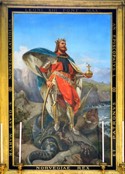Windh/Freise/Maurstad genealogy - Person Sheet
Windh/Freise/Maurstad genealogy - Person Sheet
Death29 Jul 1030, Battle of Stiklestad
Birth995, Ringerike, Norway
OccupationKing Olaf II of Norway, Saint Olaf
Religionclick his name for a long Wikipedia entry
EducationKing from 1015 to 1028.
FatherKing Harald “Grenske” GUDRØDSSON (ca960-ca995)
MotherÅsta Astrid GUDBRANDSDATTER Queen of Norway (970-1030)
Misc. Notes
Olaf II of Norway - Saint Olaf - Wikipedia
Olaf II Haraldsson (995 – 29 July 1030), later known as St. Olaf, was King of Norway from 1015 to 1028. He was canonised at Nidaros (Trondheim) by Bishop Grimkell, one year after his death in the Battle of Stiklestad on 29 July 1030. His remains were enshrined in Nidaros Cathedral, built over his burial site. His sainthood encouraged the widespread adoption of the Christian religion.
The saga of Olav Haraldsson and the legend of Olaf the Saint became central to a national identity. Especially during the period of Romantic Nationalism, Olaf was a symbol of Norwegian independence and pride. Saint Olaf is symbolised by the axe in Norway's coat of arms, and Olsok (29 July) is still his day of celebration. Many Christian institutions with Scandinavian links as well as Norway's Order of St. Olav are named after him.
During his lifetime he was known as Olaf 'the fat' or 'the stout' or simply as Olaf 'the big.' His mother was Åsta Gudbrandsdatter, and his father was Harald Grenske, great-great-grandchild of Harald Fairhair, the first king of Norway. Harald Grenske died when Åsta Gudbrandsdatter was pregnant with Olaf. She later married Sigurd Syr, with whom she had other children including Harald Hardrada, who would reign as a future king of Norway.
In 1019 Olaf married Astrid Olofsdotter, King Olof's illegitimate daughter and the half-sister of his former fiancée. The union produced a daughter, Wulfhild, who married Ordulf, Duke of Saxony in 1042. Numerous royal, grand ducal and ducal lines are descended from Ordulf and Wulfhild, including members of the House of Saxe-Coburg and Gotha. Maud of Wales, daughter of King Edward VII of the United Kingdom, was the mother of King Olav V of Norway, so Olav and his son Harald V, the present King of Norway, are thus descended from Olaf.
But Olaf's success was short-lived. In 1026 he lost the Battle of the Helgeå, and in 1029 the Norwegian nobles, seething with discontent, supported the invasion of King Cnut the Great of Denmark. Olaf was driven into exile in Kievan Rus. He stayed for some time in Sweden in the province of Nerike where, according to local legend, he baptised many locals. In 1029, King Cnut's Norwegian regent, Jarl Håkon Eiriksson, was lost at sea. Olaf seized the opportunity to win back the kingdom, but he fell in 1030 at the Battle of Stiklestad, where some of his own subjects from central Norway took arms against him. The exact position of Saint Olaf's grave in Nidaros has been unknown since 1568, due to the effects of the Lutheran iconoclasm in 1536–37.
Olaf II Haraldsson (995 – 29 July 1030), later known as St. Olaf, was King of Norway from 1015 to 1028. He was canonised at Nidaros (Trondheim) by Bishop Grimkell, one year after his death in the Battle of Stiklestad on 29 July 1030. His remains were enshrined in Nidaros Cathedral, built over his burial site. His sainthood encouraged the widespread adoption of the Christian religion.
The saga of Olav Haraldsson and the legend of Olaf the Saint became central to a national identity. Especially during the period of Romantic Nationalism, Olaf was a symbol of Norwegian independence and pride. Saint Olaf is symbolised by the axe in Norway's coat of arms, and Olsok (29 July) is still his day of celebration. Many Christian institutions with Scandinavian links as well as Norway's Order of St. Olav are named after him.
During his lifetime he was known as Olaf 'the fat' or 'the stout' or simply as Olaf 'the big.' His mother was Åsta Gudbrandsdatter, and his father was Harald Grenske, great-great-grandchild of Harald Fairhair, the first king of Norway. Harald Grenske died when Åsta Gudbrandsdatter was pregnant with Olaf. She later married Sigurd Syr, with whom she had other children including Harald Hardrada, who would reign as a future king of Norway.
In 1019 Olaf married Astrid Olofsdotter, King Olof's illegitimate daughter and the half-sister of his former fiancée. The union produced a daughter, Wulfhild, who married Ordulf, Duke of Saxony in 1042. Numerous royal, grand ducal and ducal lines are descended from Ordulf and Wulfhild, including members of the House of Saxe-Coburg and Gotha. Maud of Wales, daughter of King Edward VII of the United Kingdom, was the mother of King Olav V of Norway, so Olav and his son Harald V, the present King of Norway, are thus descended from Olaf.
But Olaf's success was short-lived. In 1026 he lost the Battle of the Helgeå, and in 1029 the Norwegian nobles, seething with discontent, supported the invasion of King Cnut the Great of Denmark. Olaf was driven into exile in Kievan Rus. He stayed for some time in Sweden in the province of Nerike where, according to local legend, he baptised many locals. In 1029, King Cnut's Norwegian regent, Jarl Håkon Eiriksson, was lost at sea. Olaf seized the opportunity to win back the kingdom, but he fell in 1030 at the Battle of Stiklestad, where some of his own subjects from central Norway took arms against him. The exact position of Saint Olaf's grave in Nidaros has been unknown since 1568, due to the effects of the Lutheran iconoclasm in 1536–37.
Spouses
Deathaft 1035
BirthSweden
EducationKing Olav II of Norway
Religionclick her name for a Wikipedia entry
OccupationSwedish princess and then Queen Consort of
FatherKing Olof SKÖTKONUNG King of Sweden (ca980-ca1022)
MotherEdla FRÅN Duchess of Venden (984-1008)
Misc. Notes
Astrid Olofsdotter of Sweden - Wikipedia
Astrid was described as beautiful, articulate and generous, and well liked by others. She was the mother of Wulfhild of Norway (1020–1070), wife of Ordulf, Duke of Saxony and the stepmother of King Magnus the Good, with whom she had a good relationship. In 1030, she was widowed when her husband was killed. She left Norway and settled in the Swedish court, where she had a high position. When her stepson Magnus visited Sigtuna on his way to claim the Norwegian throne, she gave him her official support and encouraged Sweden to do so as well.
Astrid was described as beautiful, articulate and generous, and well liked by others. She was the mother of Wulfhild of Norway (1020–1070), wife of Ordulf, Duke of Saxony and the stepmother of King Magnus the Good, with whom she had a good relationship. In 1030, she was widowed when her husband was killed. She left Norway and settled in the Swedish court, where she had a high position. When her stepson Magnus visited Sigtuna on his way to claim the Norwegian throne, she gave him her official support and encouraged Sweden to do so as well.
Marriage1019
ChildrenUlvhild (1020-1071)
Birthca 1000, Bergen Norway
Deathca 1040
Occupationoriginally a slave (thrall) to Olav’s wife Astrid
Unmarried
ChildrenMagnus I “The Good” (1024-1047)



